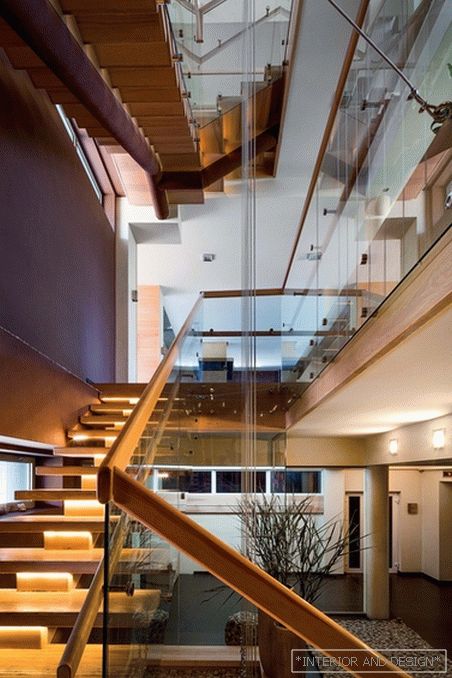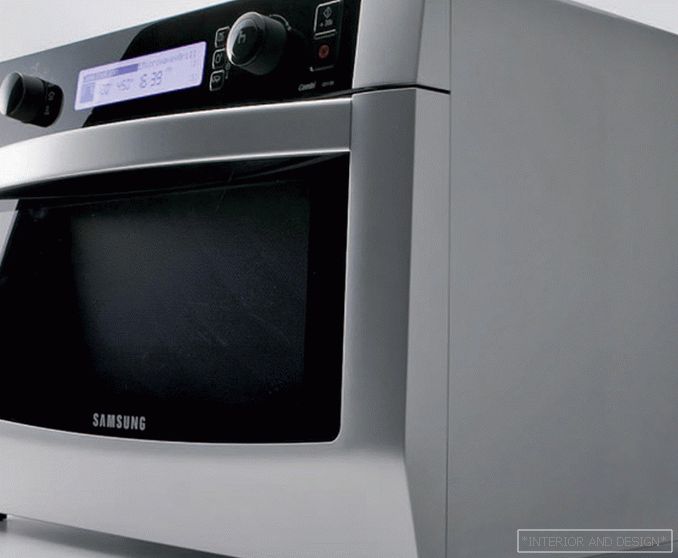Architect and designer Vincenzo De Cotis is one of the most interesting and sought-after contemporary authors. Vincenzo recently updated his Milan interior. About work, favorite city and the phenomenon of "Italian design" - his special story for readers INTERIOR + DESIGN.
By topic: The most fashionable designer. Brutality and artistry Vincenzo De Cotis
Graduate of the Milan Polytechnic De Kotis loves brutal spaces, large scale, mean lines, recycling products. Each object he painted looks like a detail of a large architecture. It draws up hotels and boutiques, private residences, is successful in subject design: it accumulates the main creative energy for non-trivial orders, constantly expanding the collection of author's series and unique collections of Progetto Domestico. These items are easily identified by the abbreviation DC in the title. There are a lot of them in the Vincenzo de Cotis house in Milan - apartments in the palace of the 18th century.
Related: Vincenzo de Cotiis (Vincenzo de Cotiis): tables with an African character
“Italians tend to have a special sense of beauty, this“ trace ”leads to the times of ancient Rome. But today, perhaps, I am more interested in the Italian ability to mix various aesthetic and formal means of expression, which ultimately gives rise to a phenomenon called “Italian design”. Many masters took part in its formation, of which Carlo Scarpa influenced me the most: with his courage, unexpected tricks and attention to nuances. ”
"Among my points of attraction are Fondazione Prada, as well as Fondazione Albini, constant sources of inspiration and new ideas."
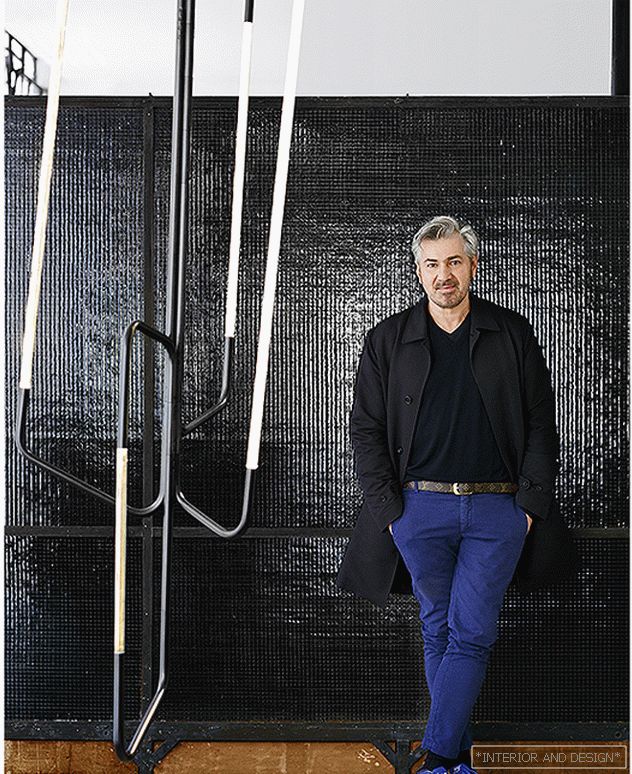 The owner of the house is next to a giant candlestick from the Progetto Domestico collection: it includes limited edition items and unique writings by Vincenzo De Cotis, each of which has the abbreviation DC in its name.
The owner of the house is next to a giant candlestick from the Progetto Domestico collection: it includes limited edition items and unique writings by Vincenzo De Cotis, each of which has the abbreviation DC in its name. Vincenzo De Cotis chose apartments in an 18th-century palazzo in the historic center of Milan for living. And he did everything to return the space to its former splendor. The new owner cleaned it of late layers, revealing the remains of ancient plasters and frescoes under the layers of wallpaper and suspended ceilings, while, importantly, did not overdo it: being a master with impeccable taste, did not disguise the traces of time, avoiding the feeling of replica.
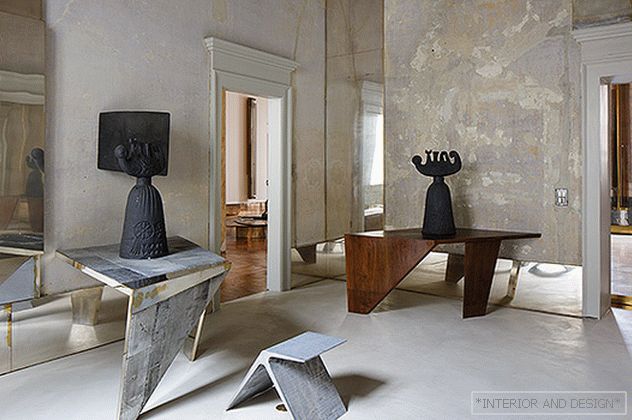 Console DC1524 from old radiators, stool DC1402A from cast aluminum, console DC1525 from recycled wood.
Console DC1524 from old radiators, stool DC1402A from cast aluminum, console DC1525 from recycled wood. “The apartments were in good condition, they have authentic floors and ceilings,” says De Cotis. - It was a real miracle - to find a property in this state! I can not say that I ran into serious problems in my work, except that some premises had to be “connected” to engineering communications. In the process of reconstruction I enriched the source with textures that were in contrast with it. He created a kind of casket, visually bright, while full of dignity and nobility. In the interior there are both things that I have designed, and "alien", including unnamed works. I must confess that I am constantly updating my house and am still looking for furnishings. ”
 Silver plated brass and recycled fiberglass table DC1505, Progetto Domestico. Chairs, diz. W. Platner for Knoll, combined with Venetian samples of the XVIII century.
Silver plated brass and recycled fiberglass table DC1505, Progetto Domestico. Chairs, diz. W. Platner for Knoll, combined with Venetian samples of the XVIII century. 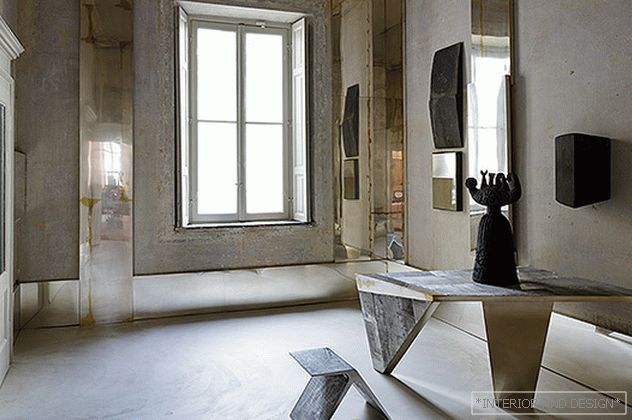 Console DC1524 from old radiators, stool DC1402A from cast aluminum.
Console DC1524 from old radiators, stool DC1402A from cast aluminum. 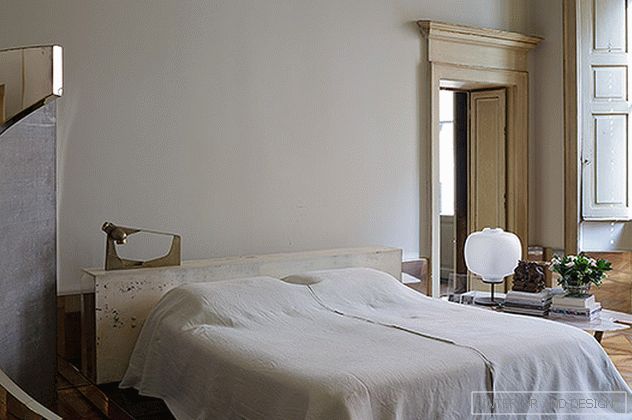 The bedroom is dominated by objects from the Progetto Domestico collection: a covering screen made of brass and fiberglass DC1515B, a lamp made of cast brass DC 1620.
The bedroom is dominated by objects from the Progetto Domestico collection: a covering screen made of brass and fiberglass DC1515B, a lamp made of cast brass DC 1620. “I have long settled in Milan, but even if I lived in some other place, Milan would remain a guide for me, a reference point in my coordinate system. This is a special city that everyone has to discover. You don't fall in love with it right away, you need to know it, having tasted hiding places. In recent years, Milan has certainly become more interesting thanks to the investments of great philanthropists. ”
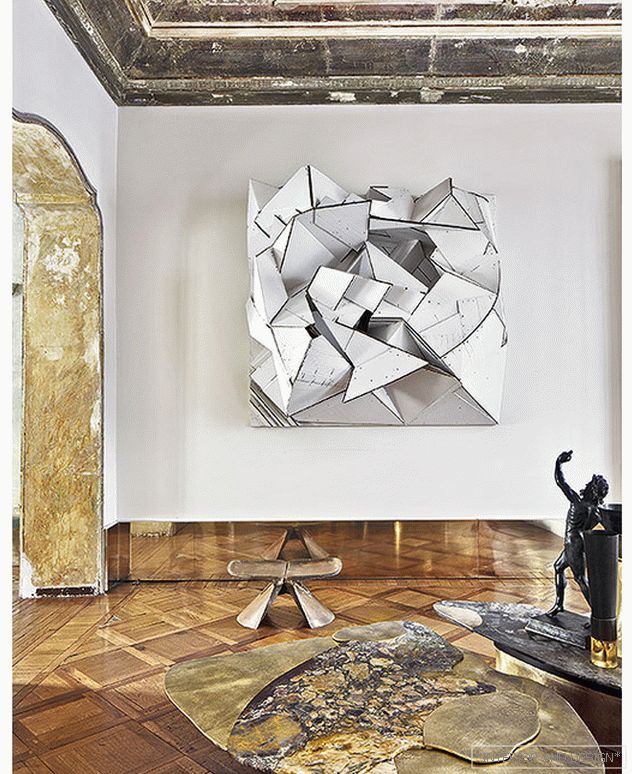 On the wall is the work of German artist F. Baudreksel. A vintage 1970s Scandinavian fiberglass stool is reflected in a brass plinth. DC1601A and DC1601B - tables made of marble and cast brass (call. Progetto Domestico).
On the wall is the work of German artist F. Baudreksel. A vintage 1970s Scandinavian fiberglass stool is reflected in a brass plinth. DC1601A and DC1601B - tables made of marble and cast brass (call. Progetto Domestico). “I like to go shopping and flea markets and enjoy unexpected finds. Furniture is of great value to me, it seems to me that they live their own lives. The process in which I create my objects is akin to the work of a sculptor rather than a designer. Features of my expressive language: fanatical attention to detail, craft craftsmanship, artistic expression, artistry, coupled with the functionality of objects and space. "
“I avoid the concept of“ my style ”because style is a constant. And my project is different from all previous ones and is tailored to the standards of a single person. ”
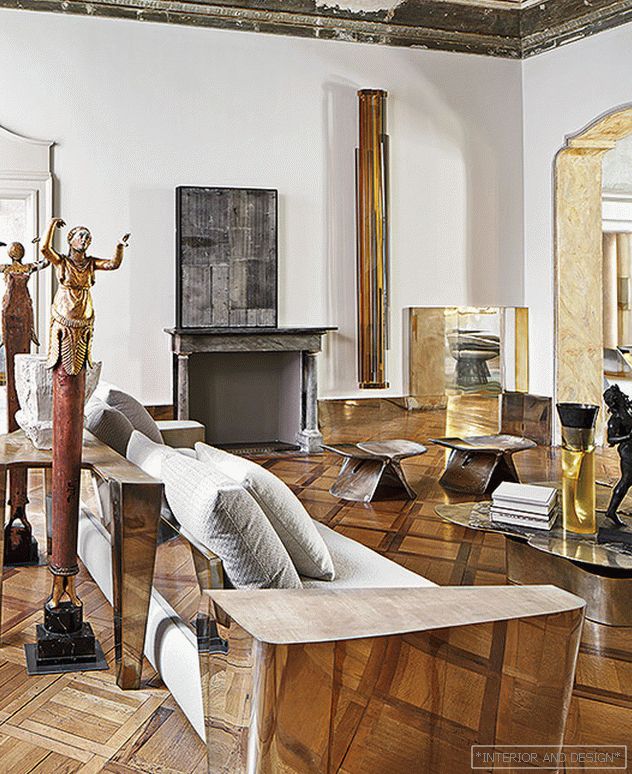 Divan V. De Cotis designed specifically for his home. Behind him is a DC1628 console made from recycled fiberglass and silver-plated brass. On the fireplace panels from old radiators. On the wall is a DC1507 lamp made of brass and colored glass.
Divan V. De Cotis designed specifically for his home. Behind him is a DC1628 console made from recycled fiberglass and silver-plated brass. On the fireplace panels from old radiators. On the wall is a DC1507 lamp made of brass and colored glass. 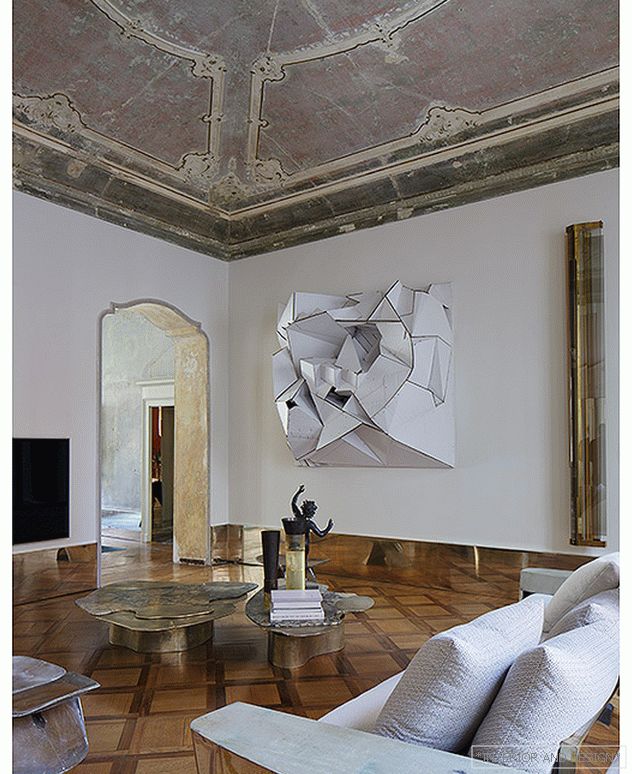 On the wall is the work of German artist F. Baudreksel. DC1601A and DC1601B - tables made of marble and cast brass (call. Progetto Domestico).
On the wall is the work of German artist F. Baudreksel. DC1601A and DC1601B - tables made of marble and cast brass (call. Progetto Domestico). 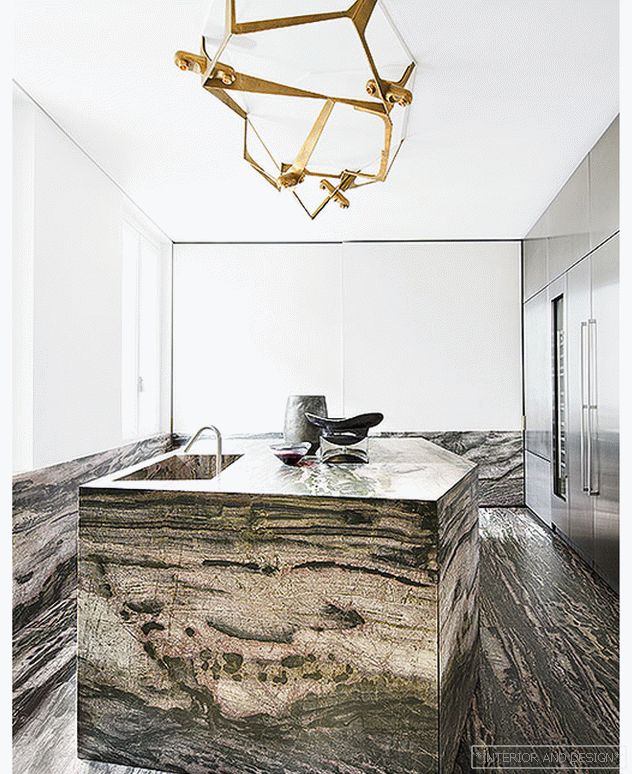 Kitchen made to order in Brazilian marble. The refrigerator, as well as other built-in appliances, is from the German brand Gaggenau.
Kitchen made to order in Brazilian marble. The refrigerator, as well as other built-in appliances, is from the German brand Gaggenau.  Kitchen made to order in Brazilian marble. The refrigerator, as well as other built-in appliances, is from the German brand Gaggenau.
Kitchen made to order in Brazilian marble. The refrigerator, as well as other built-in appliances, is from the German brand Gaggenau. “I like all colors, if their use is due to the artistic intent, - I use bright colors when I want to perform more artistic, in other cases I prefer natural colors. In particular, on vast surfaces vary shades of gray. I love the materials obtained as a result of recycling, including various types of metal, which I reinterpret depending on the context. As you can tell from my interior, I am a supporter of contrasts. ” De Kotis, as no one else knows how to push together rich and poor textures, combine silver-plated brass with recycled plastic, achieving ultimate luxury. Designer's know-how: baseboards made of polished to a mirror shine of brass - they can be evaluated in this project.
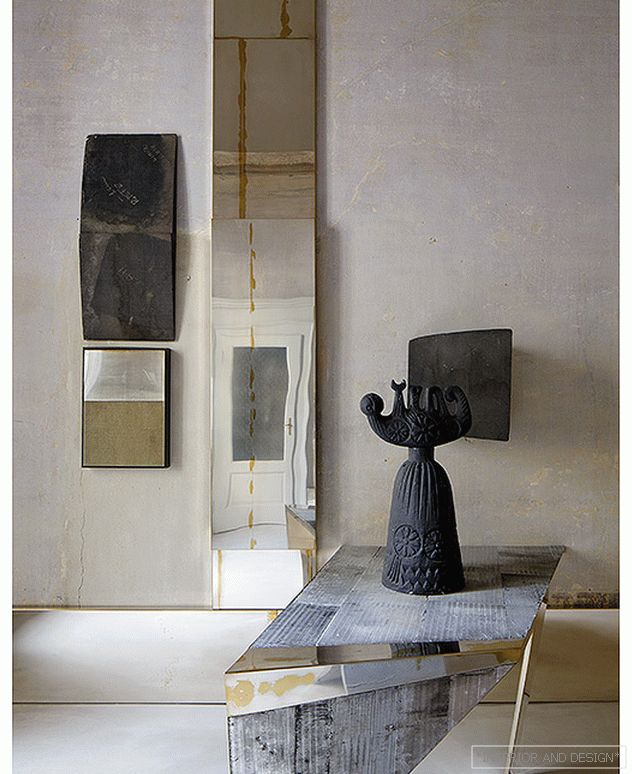 Console DC1524 from old radiators.
Console DC1524 from old radiators. 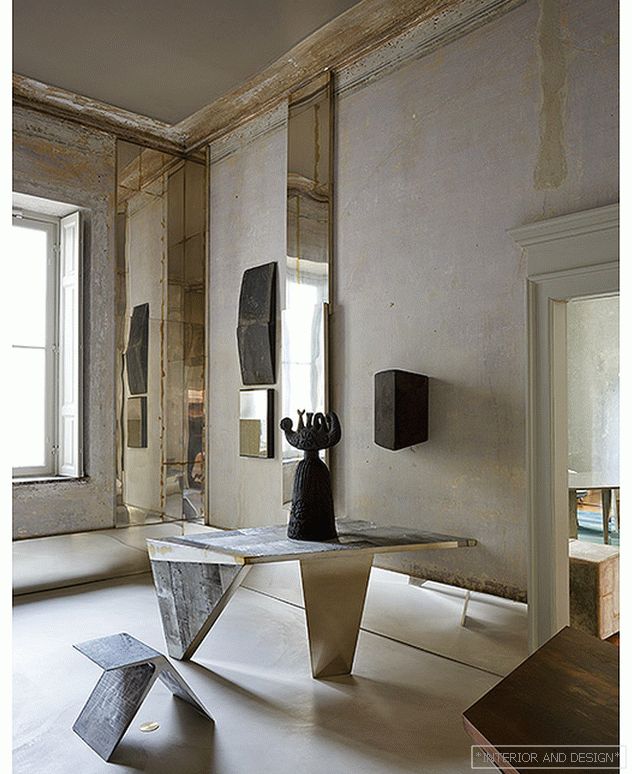 Console DC1524 from old radiators, stool DC1402A from cast aluminum, console DC1525 from recycled wood.
Console DC1524 from old radiators, stool DC1402A from cast aluminum, console DC1525 from recycled wood. 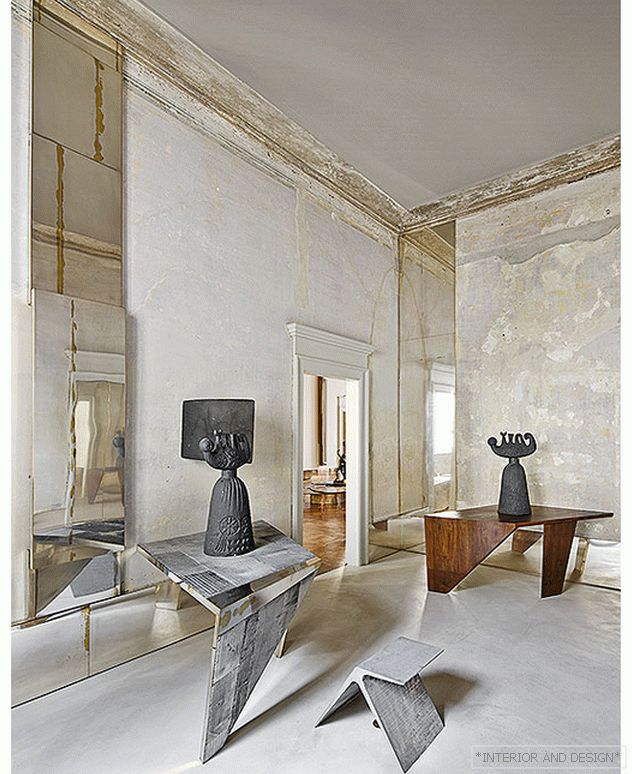 Console DC1524 from old radiators, stool DC1402A from cast aluminum, console DC1525 from recycled wood.
Console DC1524 from old radiators, stool DC1402A from cast aluminum, console DC1525 from recycled wood. “I am curious about everything that happens in the surrounding world, especially in the field of art and architecture, I greedily absorb new impressions. However, I think that the impact on creativity comes from areas that are not directly related to our segment. I do not like trends, because I appreciate the individuality of expression. The concept of luxury is too littered with commerce, but if you use it in its purest form, then modern luxury means being surrounded by people and things that you really care about. ”
 Reading room. The DC1514 rack is installed unconventionally - away from the wall. Firstly, in order to examine the object from all sides, and secondly - not to close the authentic color border on the wall.
Reading room. The DC1514 rack is installed unconventionally - away from the wall. Firstly, in order to examine the object from all sides, and secondly - not to close the authentic color border on the wall.  Table DC1505 in silver plated brass and recycled fiberglass. Lamp-panel DC1508 of stained glass and brass. (All - Progetto Domestico). Chairs, diz. W. Platner for Knoll, combined with Venetian samples of the XVIII century.
Table DC1505 in silver plated brass and recycled fiberglass. Lamp-panel DC1508 of stained glass and brass. (All - Progetto Domestico). Chairs, diz. W. Platner for Knoll, combined with Venetian samples of the XVIII century. 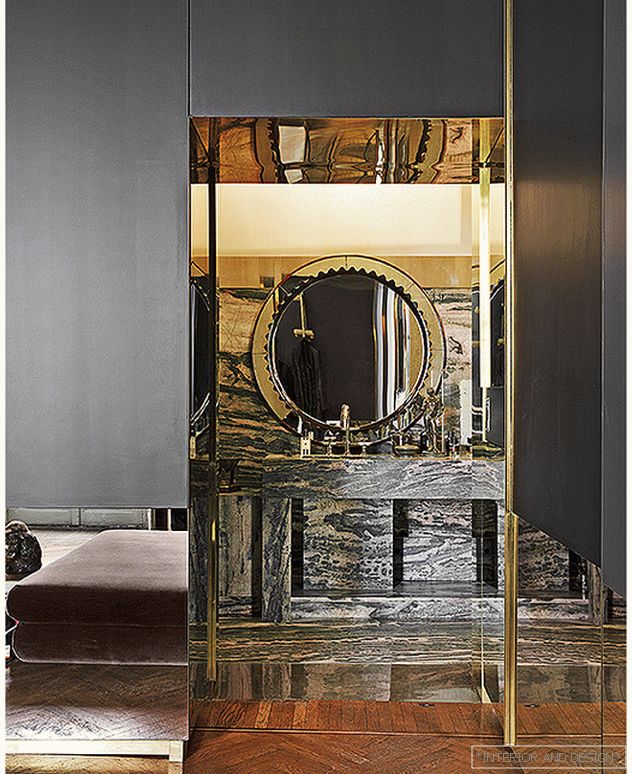 The bathroom is finished with Brazilian marble. Above the sink is a vintage round mirror.
The bathroom is finished with Brazilian marble. Above the sink is a vintage round mirror. 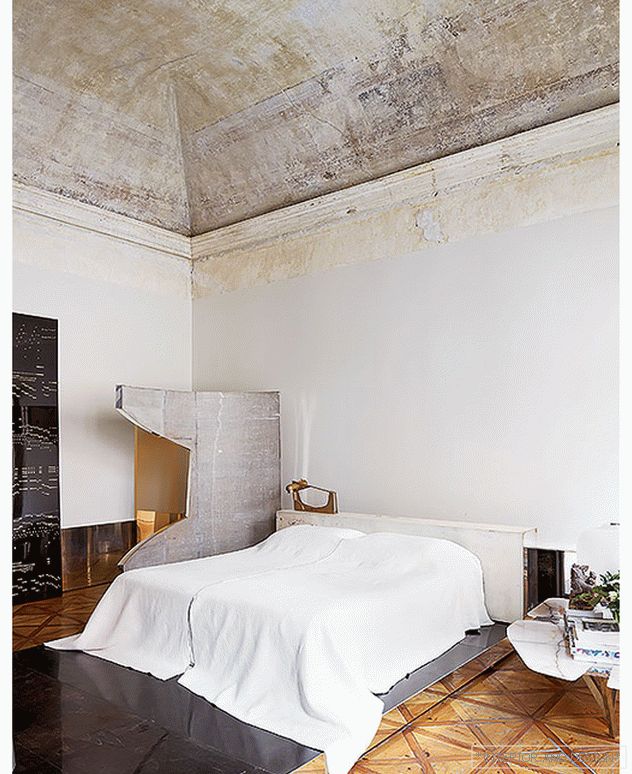 The bedroom is dominated by objects from the Progetto Domestico collection: a covering screen made of brass and fiberglass DC1515B, a lamp made of cast brass DC 1620, a chair in leather upholstery DC102.
The bedroom is dominated by objects from the Progetto Domestico collection: a covering screen made of brass and fiberglass DC1515B, a lamp made of cast brass DC 1620, a chair in leather upholstery DC102. 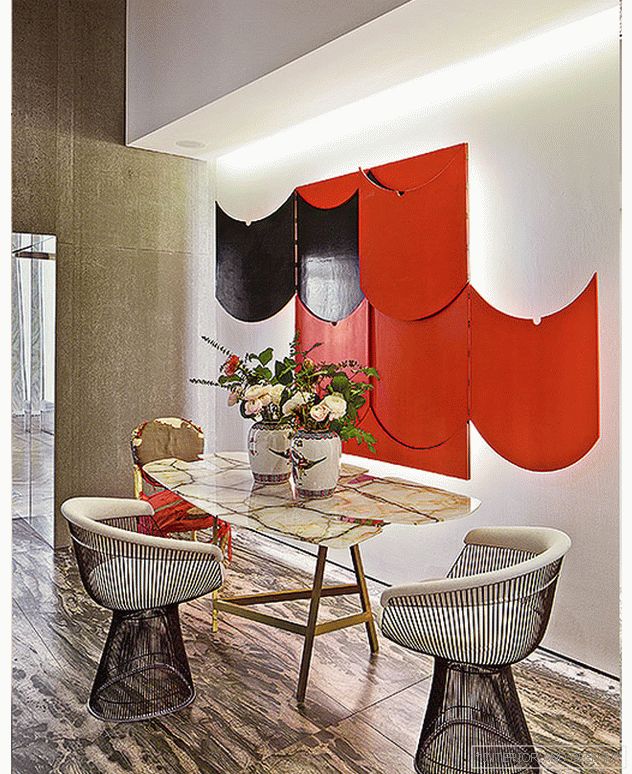 Kitchen. On the wall is a panel of Japanese artist K. Nakai (1960s). Table DC1401 in brass and onyx. Design chairs by W. Plattner for Knoll.
Kitchen. On the wall is a panel of Japanese artist K. Nakai (1960s). Table DC1401 in brass and onyx. Design chairs by W. Plattner for Knoll. 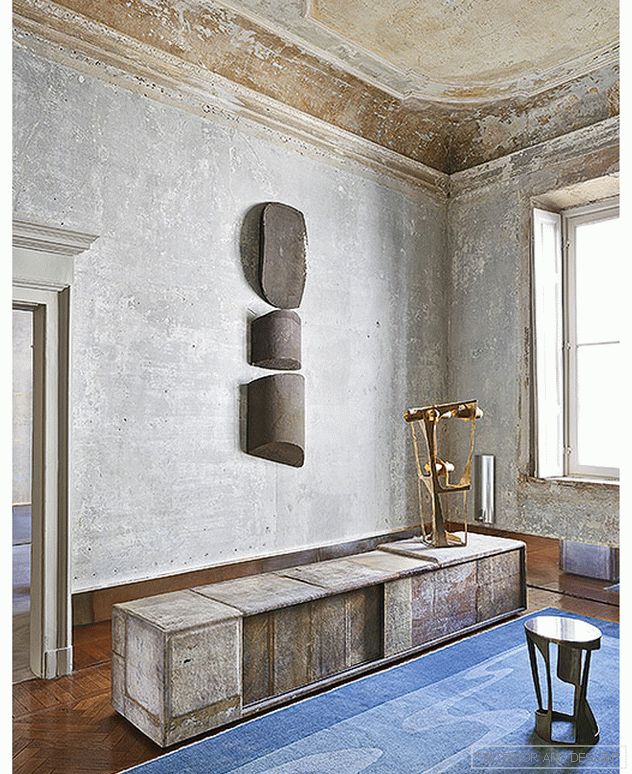 DC317 curbstone from recycled fiberglass - one of the first works of De Cotis designer. On the wall are fragments of the theatrical scenery from the polystyrene of the 1980s. Brass lamp DC1623. The table combines two types of brass: cast and silver.
DC317 curbstone from recycled fiberglass - one of the first works of De Cotis designer. On the wall are fragments of the theatrical scenery from the polystyrene of the 1980s. Brass lamp DC1623. The table combines two types of brass: cast and silver. 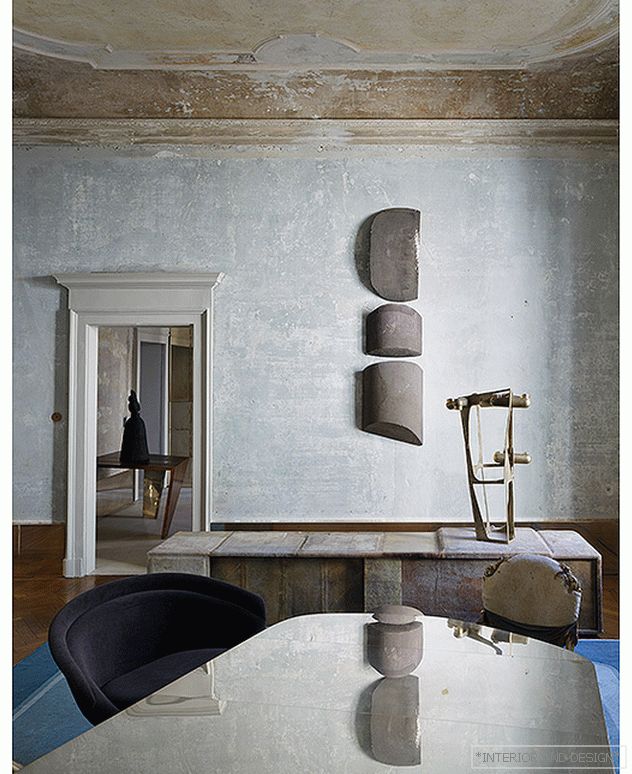 DC317 curbstone from recycled fiberglass - one of the first works of De Cotis designer. On the wall are fragments of the theatrical scenery from the polystyrene of the 1980s. Brass lamp DC1623. The table combines two types of brass: cast and silver.
DC317 curbstone from recycled fiberglass - one of the first works of De Cotis designer. On the wall are fragments of the theatrical scenery from the polystyrene of the 1980s. Brass lamp DC1623. The table combines two types of brass: cast and silver. 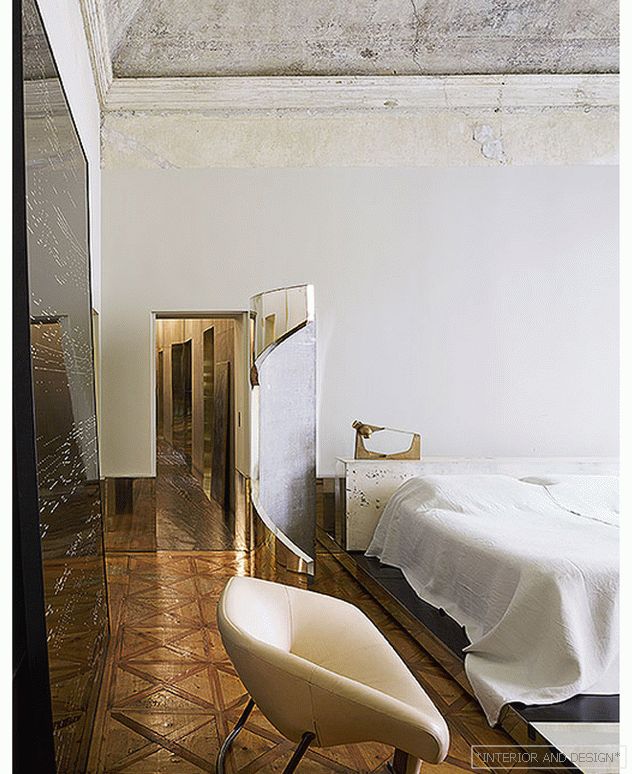 The peculiarity of the bedroom is a folding screen that covers the bed: the entrance to the bathroom is located nearby. On the left, against the wall is the art-panel DC503.
The peculiarity of the bedroom is a folding screen that covers the bed: the entrance to the bathroom is located nearby. On the left, against the wall is the art-panel DC503. 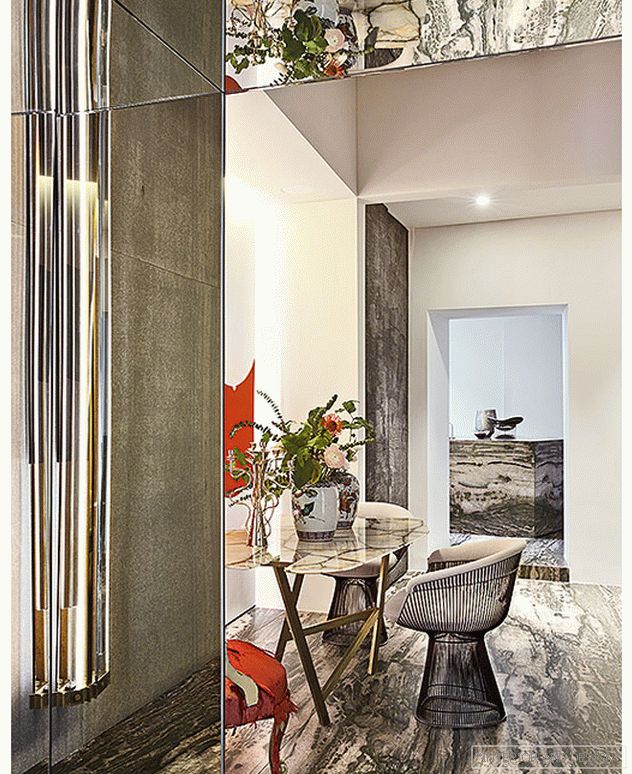 In the kitchen there is a small dining room for breakfast.
In the kitchen there is a small dining room for breakfast. 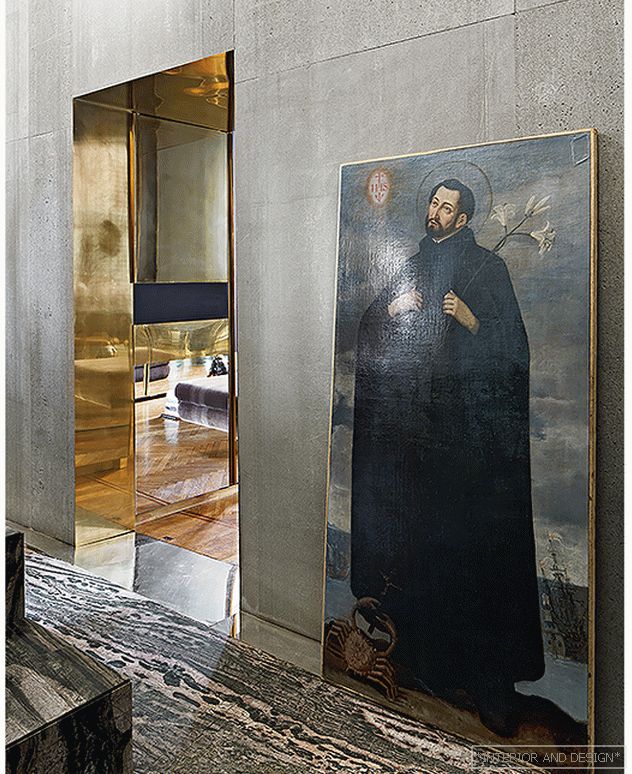 In the bathroom the master of the house put a large work of an unknown master of the XIX century.
In the bathroom the master of the house put a large work of an unknown master of the XIX century. 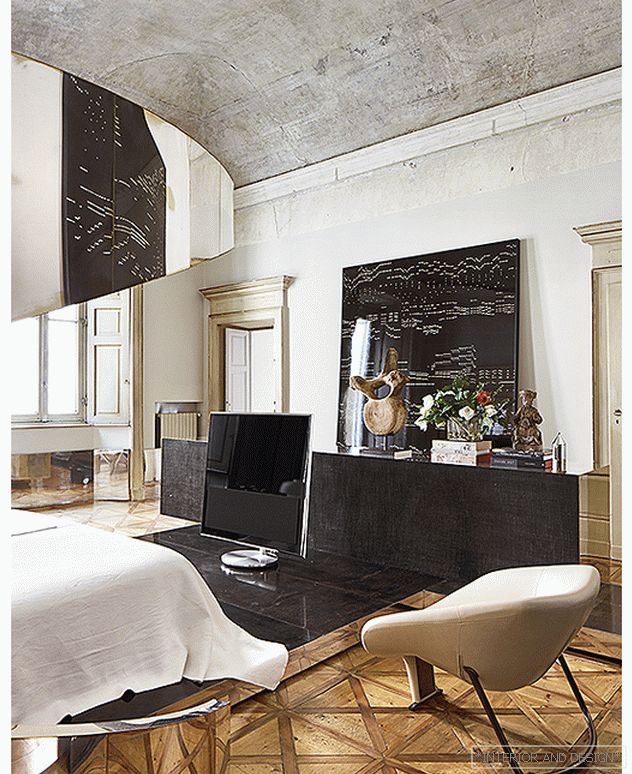 Телевизор Bang & Olufsen в подобном контексте выглядит как произведение искусства.
Телевизор Bang & Olufsen в подобном контексте выглядит как произведение искусства. 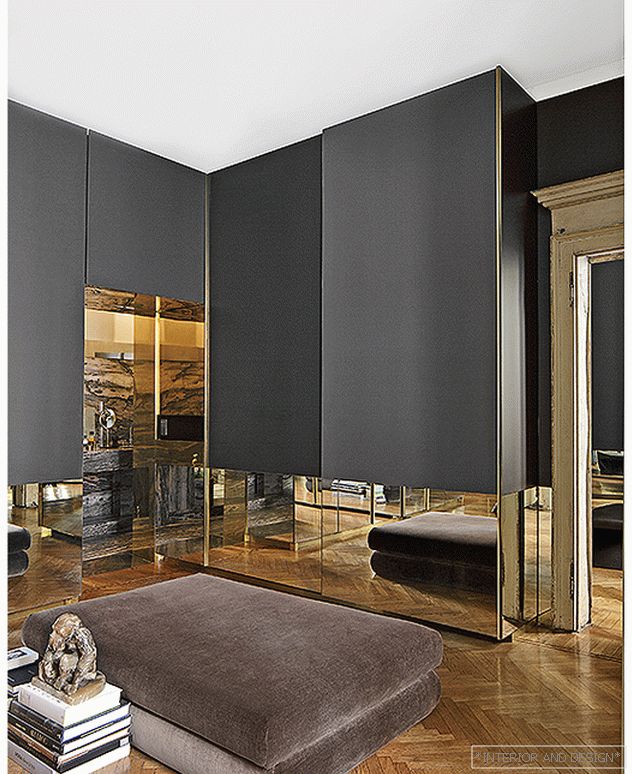 Dressing room is interpreted as a living room. Cabinets combine wood in a matte finish of a noble dark tone, brass and mirrors.
Dressing room is interpreted as a living room. Cabinets combine wood in a matte finish of a noble dark tone, brass and mirrors. 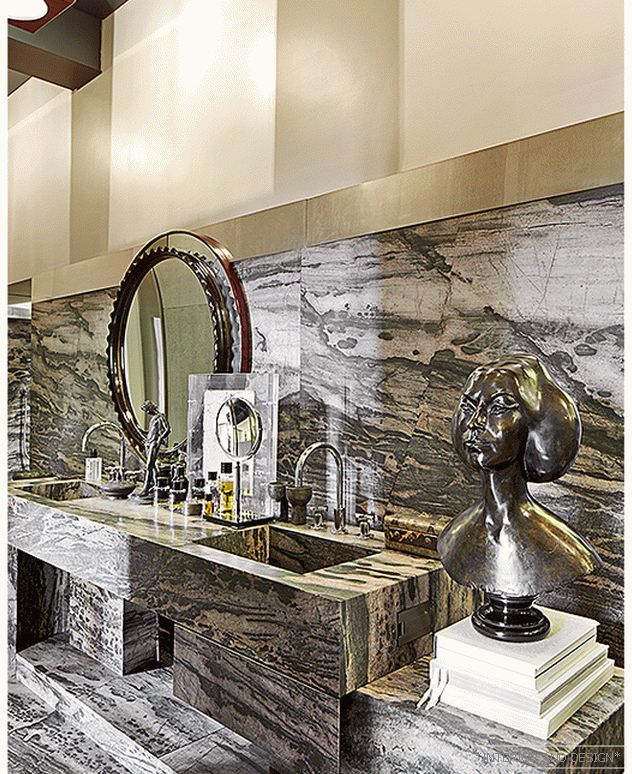 A washbasin with two sinks, like a sculpture carved from a single block of marble.
A washbasin with two sinks, like a sculpture carved from a single block of marble. 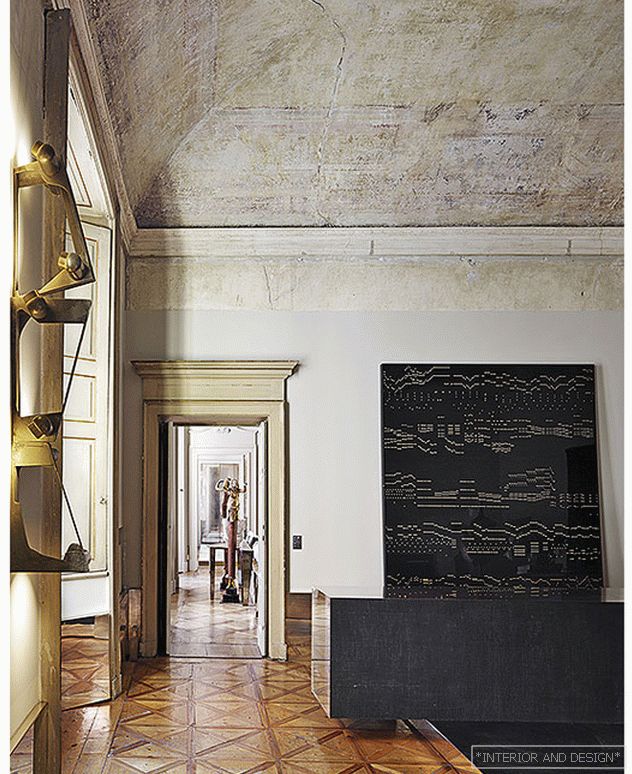 The apartments have a beautiful enfilade layout. Left on the wall is a DC1622 lamp.
The apartments have a beautiful enfilade layout. Left on the wall is a DC1622 lamp. 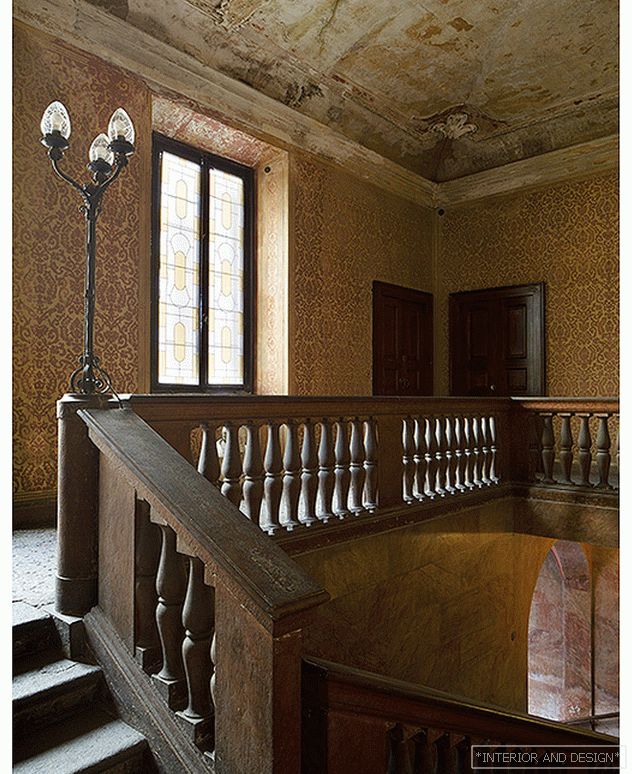 Stairs leading to the apartment.
Stairs leading to the apartment.  Exit to the courtyard.
Exit to the courtyard. 
